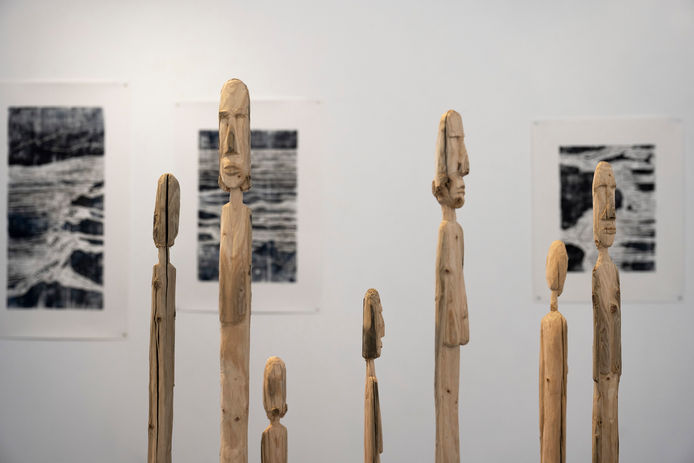"KOROT"
Artist:
ספט׳
2022
All Gallery
Curator: Tze’ela Kotler Hadari
Click image to view Catalog
KOROT
בתערוכת היחיד "קורות" מציג האמן גיא סער רוסו סדרת עבודות הכוללת הדפס ופיסול, שנעשו ברובן בשנה האחרונה (2022). הסדרות נולדו מתוך מחקר והתבוננות במקומי - הפרטי והקולקטיבי.
עבודות ההדפס הייחודיות של סער רוסו החלו בסדרת רישומים שנעשו בחופי סיני או בהשראת המקום, עם המבט אל ההרים ואל הים. את העץ לגלופות הוא מפרק מרהיטים, בתי תפילה, בתים לפני שיפוץ, או עצים שנמצאו לצד הדרך. עבודת הגריעה בגלופות נעשית בכלים ידניים ובסיסיים. ההדפסות נעשות גם כן באופן ידני, במספר עותקים מצומצם ובצבעי שמן; בדרך כלל בגווני כחול פּרוּסי ואינדיגו.
את סדרת הפסלים שבהם מתוארות חיות "עבריות" או "כנעניות" בנות המקום, או כאלו שנכחדו, יצר האמן בהשראת מערות שׁוֹבֶה (Chauvet Cave) שנחשפו ב-1994 בצרפת. התגלו בהן ציורי חיות ואמנות מערות המיוחסת לתקופה הפלאוליתית, לפני כ-35 אלף שנה. ממצאים אלו מכונים "השחר של האמנות."
גם סער רוסו מתעניין בשחר. במקור ובקורות החומר, העם, השבט, האנושות, הקיום. כמו הממצאים במערות שובה גם עבודותיו מבקשות להיות זיכרון פרטי וקולקטיבי המוטבע בחומר, בעץ. תהליך החיפוש והגריעה נחווה כפעולה ארכיאולוגית עמלנית, שמתחילה ברישום ומתהווה.
בעבודות הפיסול משאיר האמן את הבסיסים של החומר ממנו בקעו היצורים, שנחווים לא פעם כיצורים מיתיים או תנ"כים, כאלה שנמשלים לתאולוגיות שונות או שיצאו מסצנות ארכיטיפיות. גם סדרות הדמויות אותן מפסל האמן נותרות נטועות בבסיס החומר, כזנבות לקורות העץ – מהן נולדות כל הצורות. הגלופות המובילות להדפסים הן אובייקט העומד בפני עצמו כסמן בחיפוש אחר ראשית הדברים.
גוף העבודות של סער רוסו מבקש מהצופה להתעמת עם הפרה-היסטורי, עם כוחות הטבע והזרמים הסוחפים בים, עם סופות חול במדבר, ועם נפשות שאינן אדם ביער קדום. כאדם שנולד מאדם, כצורה הנולדת מהחומר, יוצר האמן מים מעץ ומגלף נדודים. בתהליך ההפשטה הוא מבטא את הבעירה לגלות מה נמצא מתחת לפני השטח ואיננו רואים.
מתוקף היותו בן שליחים, סער רוסו נדד מילדותו מארץ לארץ עד שהתיישב בשנים האחרונות בעין כרם בירושלים, והוא יוצר בסטודיו בעין יעל. העבודות בתערוכה "קורות" הן תזכורת למצב זמני-קבוע של נדודים. כשמתייחסים למקום שבו הן נעשו, ישראל וסיני, הן נושאות גם מטען פוליטי המתייחס לאדמה, לשבטים ולהתיישבות.
סער רוסו מזכיר לצופה את האשליה שיש בנטיעת שורש, פרטי וקולקטיבי, בידיעה שגם זה רק עוד פרק אחד, מני רבים, בקורות.
טקסט: צאלה קוטלר הדרי
In his exhibition “Korot”, artist Guy Saar Ruso presents a series of works – prints and sculptures – most of which were created this past year. They are the result of research and observation of local phenomena, both private and collective.
Saar Ruso’s unique prints began as a series of drawings inspired by the Sinai beaches, gazing at the mountains and the sea. Wood for the printing blocks was taken from discarded furniture, prayer houses, homes facing renovation, or trees found at the roadside. Removal from the printing blocks is carried out with basic manual tools. The prints themselves are also prepared manually, few in number, and in oil paints, usually Prussian blue and indigo.
The sculpture series describes local or extinct “Hebraic” or “Canaanite” animals inspired by the cave paintings of animals exposed on the walls of the French Chauvet Caves in 1994, dating back to the Paleolithic Era of about 35,000 years ago. These findings have been titled “the dawn of art”.
Saar Ruso, too, shows an interest in dawn, in the source and history of material, the nation, the tribe, humanity, existence. Like the cave findings, his works wish to embody both private and collective memory, imprinted in the material, in wood. The search and removal processes are experienced as archeological labor that begins with drawing and becomes sculpture.
In his sculptures, the artist leaves the bases of material from which the creatures have emerged, sometimes experienced as mythical or biblical, comparable to various theologies or taken from archetypal scenes. The series of figures sculpted by the artist remain planted in the material base, like tails of the wooden planks from which all the shapes are formed. The blocks leading to prints are an independent object signifying the search of beginnings.
Saar Ruso’s body of work requires the viewer to confront the pre-historic, the elements, the currents at sea, the desert sand storms, and inhuman souls in the primeval forest. Like humans born of the human, like form born of material, water is created by the artist out of wood and wanderings are carved. In the abstraction process he expresses the burning wish to discover that which is under the surface and remains invisible, history that has not yet been written, a forgotten truth.
A son of emissaries, Ruso wandered since childhood among countries, until he settled down in Jerusalem’s Ein Kerem, and has been working at his studio in Ein Yael. The works displayed in the exhibition “Korot” are a reminder of a temporary-permanent state of wandering. Related to their provenance, Israel and the Sinai, they also bear a political charge referring to land, tribes and settlement. Saar Ruso reminds his viewer of the illusion of rootedness – private and collective – that is merely another chapter, one of many, in history.
Text: Tze’ela Kotler Hadari











